Aula Maxima
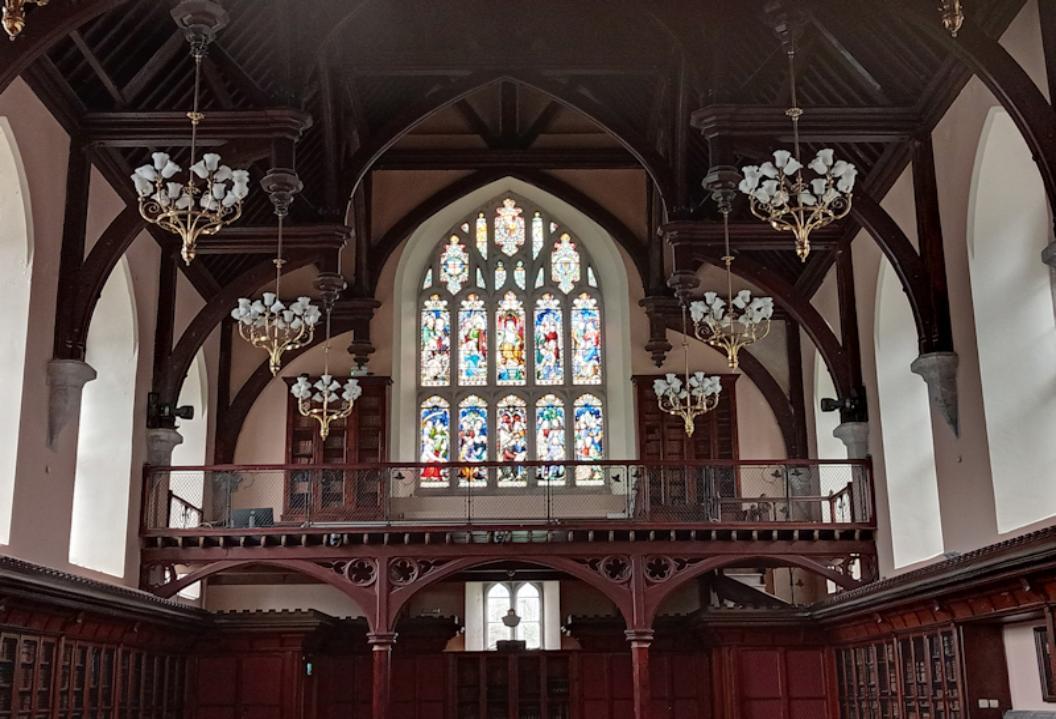
UCC was established in 1845 as one of three Queen’s Colleges at Cork, Galway and Belfast. The Cork College was especially fortunate in having Sir Thomas Deane as its architect. Deane was responsible for many public buildings in Ireland, including the Kildare Street Club, Dublin; the Museum Building, Trinity College, Dublin; and the Cork Savings Bank. In order to assist him with the design of the new college buildings, Deane who had been appointed architect in 1846, engaged the services of the architect and engineer Benjamin Woodward in the same year, who had made a set of measured drawings in 1844 of Holy Cross Abbey, Co. Tipperary, that showed an understanding of medieval detailing. Upon its completion in late 1849, the Cork College was regarded an important example of a Gothic Revival building. Deane and Woodward's achievement was aided by the dramatic setting of the building. The Western Road site was described by Deane, in 1847, as being an ‘excellent and commanding' and he also spoke about its ‘beauty and advantages' as a situation for a public building. The commanding nature of the site obviously allowed Deane and Woodward to use their skills to maximise the dramatic visual effect. Placing the larger and significant parts of the buildings – the Aula Maxima, the tower and library – close to the high cliff edge created a dramatic presence which dominated the landscape of the western edge of Cork city for many years.
On 7 November 1849, QCC opened its doors to a small group of students (only 115 students in that first session, 1849-1850) after the inaugural ceremony in the Aula Maxima (originally called the Examination Hall). This event was reported in the local press and the Illustrated London News (17 Nov 1849) together with an engraving illustrating proceedings on the day.
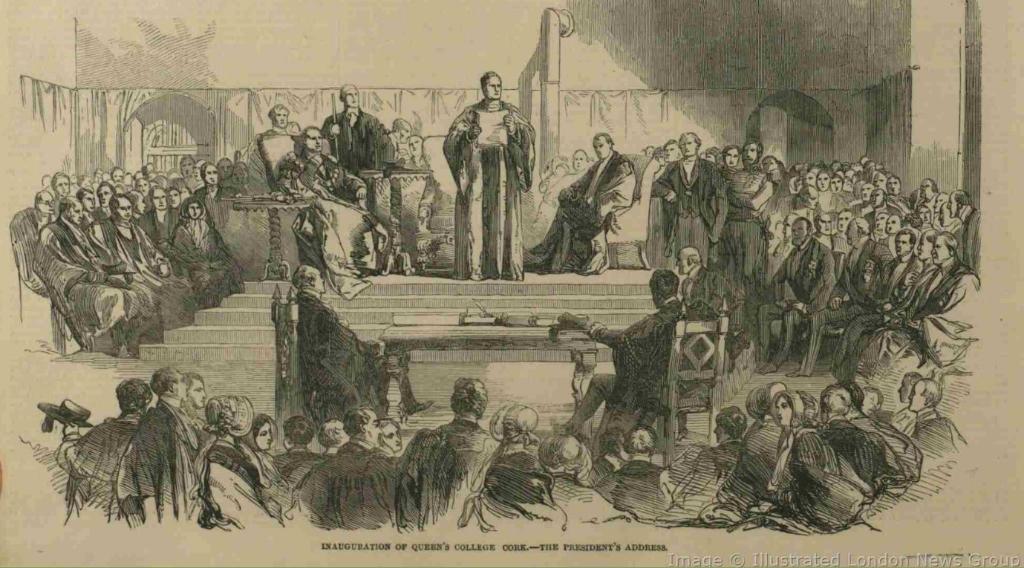
'Inauguration of Queen's College Cork–The President's Address', Illustrated London News, 17 November 1849.
Architectural Context
Research indicates that the exterior and interior of the building was inspired by two other contemporary buildings: the interior by the hall and library at Lincoln's Inn, London designed by Philip and Philip Charles Hardwick (1845); and the exterior of Francis Johnston's Chapel Royal at Dublin Castle (1814). While the Chapel Royal is regarded, by architectural historians, as a prototype for the Aula Maxima, it is possible that the statue of Queen Victoria, erected on the eastern gable over the Aula Maxima in 1849, was inspired by a similar one on the ‘Great South Gable’ of the Great Hall and Library Building at Lincoln's Inn in 1845. The hammer beamed roof of the Great Hall at Lincoln’s Inn is echoed in the roof of the Aula Maxima.
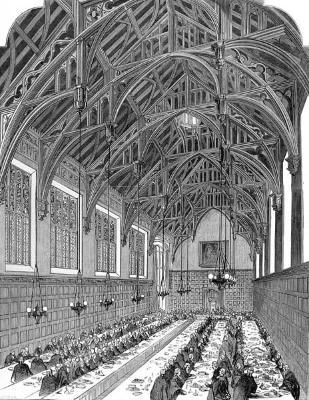
Great Hall, Lincoln's Inn, London. Engraving from the Illustrated London News, 1845.
The earliest known representation of the interior of the Aula Maxima is a watercolour painted by the architect's son Thomas Newenham Deane (1828-1899), then a student at Trinity College, Dublin. The watercolour was presented to QCC in 1849 as the architect's gift where it still remains and is now in the UCC Collections (UCCHS.1849.002).
The library, originally located in what is now the Staff Common Room and also overhead in the present Council Room, overflowed into the Aula Maxima in 1863 when the bookcases lining the walls were installed.
Presidents of Queen’s / University College Cork and their portraits
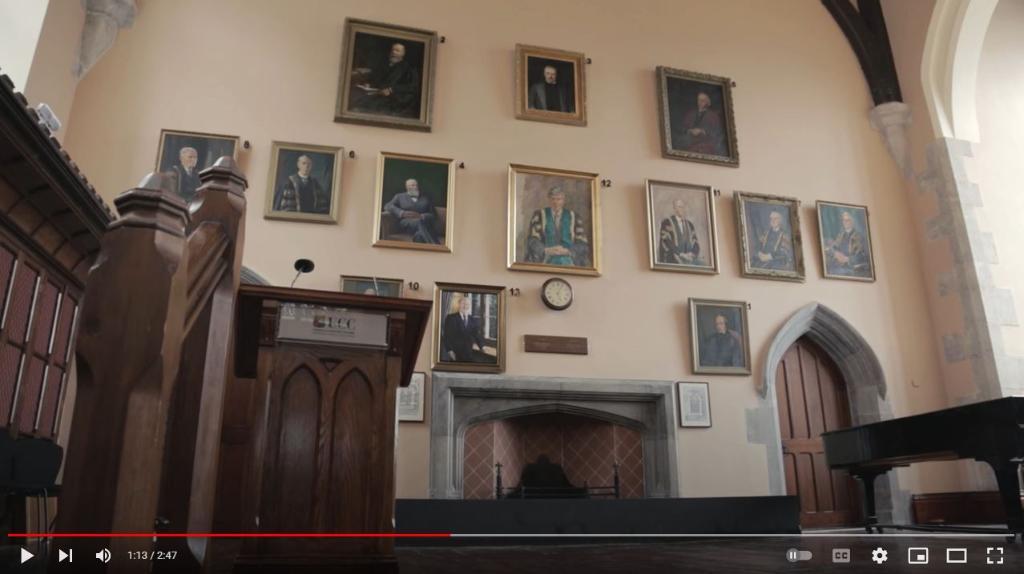
The portraits of the Presidents of Queen’s/University College Cork are hung on the western wall of the Aula Maxima and form a coherent display of the institutional history of the University. Both individually and collectively this is an assemblage of significant Irish artists, including John Butler Yeats, Derek Hill, Edward McGuire and Basil Blackshaw. Visitors can appreciate the heritage and history of the display in the august surroundings of the Aula Maxima. The Presidential Portrait collection was rehung in 2017. (Photo from 'Welcome to UCC' video.)
Sir Robert Kane - 1845-1873 – artist James Sinton Sleator PRHA (1885-1950)
William K. Sullivan - 1873-1890 – artist James Sinton Sleator PRHA (1885-1950)
James W. Slattery - 1890-1896 – artist John Butler Yeats RHA (1839-1922)
Sir Rowland Blennerhassett - 1897-1904 – artist Mark Hathaway (1960- )
Sir Bertram C. A. Windle - 1904-1919 - artist J. H. Scully RHA (c.1860-1935)
Patrick J. Merriman - 1919-1943 – artist James Sinton Sleator PRHA (1885-1950)
Alfred O'Rahilly - 1943-1954 – artist James Sinton Sleator PRHA (1885-1950)
Henry St J. Atkins - 1954-1963 – artist Somhairle MacCana ARCA (1901-1975)
John J. McHenry - 1964-1967 – artist Somhairle MacCana ARCA (1901-1975)
Michael D. McCarthy - 1967-1978 – artist Edward McGuire RHA (1932-1986)
Tadhg Ó Ciardha - 1978-1988 – artist Derek Hill HRHA (1916-2000)
Michael P. Mortell - 1989-1999 – artist Basil Blackshaw HRHA HRUA (1932-2016)
Gerard T. Wrixon - 1999-2007 – artist Trevor Goring (1949- )
Michael B. Murphy - 2007-2017 – artist Colin Davidson RUA (1968- )
Stained Glass Memorial Windows
Boole Memorial Window
The window on the east (gable) wall commemorates George Boole FRS (1815-1864), the first Professor of Mathematics at UCC, whose algebra became the foundation of modern computer science. The memorial window was funded by gifts from his colleagues and friends and erected in 1866.
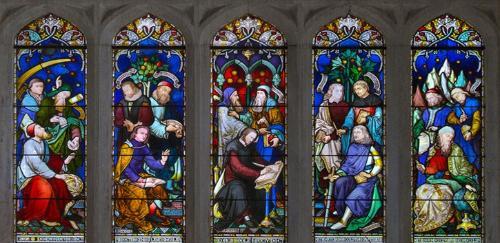
Boole Memorial Window, detail showing panels 6 to 10, with George Boole shown in central light.
The figures represented in this window are: representing religion and music (St Augustine, St Stephen and King David); navigation (Christopher Columbus, Vasco da Gama, unnamed); personification of Fame; medicine (William Harvey, Hippocrates of Kos, Galen); architecture (Archimedes, Phidias, two unnamed figures); astronomy (Nicolaus Copernicus, Hipparchus of Nicaea, Galileo di Vincenzo Bonaulti de Galilei); mathematics (Francis Bacon, John Napier, Sir Isaac Newton); mathematical logic (Aristotle, Euclid, both standing behind George Boole); philosophy (Blaise Pascal, Gottfriend Wilhelm von Leibniz; René Descartes); geography (Strabo, Claudius Ptolemy, unnamed figure).
Harkness Memorial Window
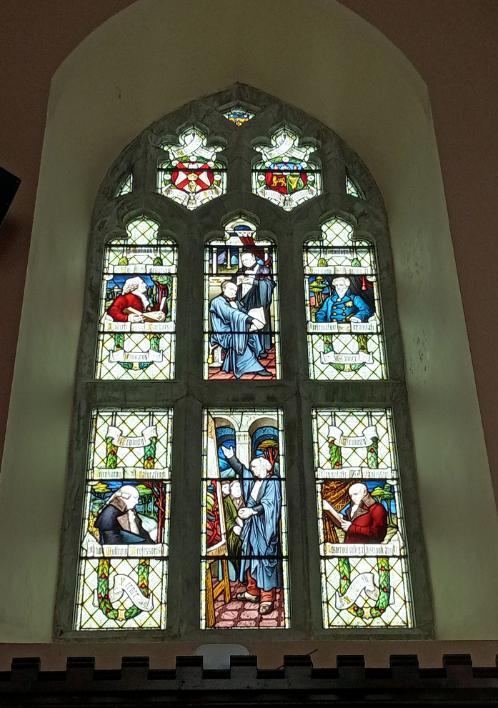
The Harkness Memorial Window (also called the ‘Professor’s Window’) on the north wall is dedicated to the memory of Robert Harkness FRS (1816-1878), Professor of Mineralogy and Geology, at Queen’s College Cork from 1853 to 1878. This window was installed in 1880 from funds raised by his former colleagues and friends. The work was also created by Messrs Hardman, Birmingham, from drawings jointly designed by the company and the Professors of QCC. It is about 14 feet in height and is divided into six lights and two roundels. The centre panel at the bottom has a full-length figure of Prof. Harkness. The other figures represented are the prominent Scottish geologists Sir Charles Lyell and Sir Roderick Murchison, the French naturalist and zoologist Georges Cuvier, the Swedish botanist and taxonomist Carl Linnaeus, the English geological cartographer William Smith and the German geologist Abraham Gottlob Werner.
Use of the Aula Maxima
Since November 1849 the Aula Maxima has served many functions both ceremonial and practical. Annually since 1850, prize-givings and awards of scholarships have been presented in the Aula Maxima. As a constituent college in the NUI since 1908, conferring ceremonies were held in UCC from 1909 onward. Until the construction of the De Vere Hall, graduates received their degrees and become members of the University when the Aula Maxima was the location of all conferring ceremonies; these occurred in Spring, Summer and Winter as well as occasional honorary conferrings.
Until the beginning of the 21st century, undergraduate students on their first day at UCC filed though the Aula Maxima to sign the admission register and generations of students have sat examinations there. Student societies have used the hall for debates and lively social functions. Also here, Presidents of UCC have been inaugurated. Musical recitals and concerts, with musicians such as Seán Ó Riada, Aloys Fleischmann, Sir Arnold Bax and Mícheál Ó Súilleabháin, have been held in the Aula Maxima. Social functions which bring together College staff and people from the locality, weddings, as well as welcoming representatives of other universities, industry and the many other countries which UCC reaches out to are held in the Aula Maxima.
Extending beyond the University walls, UCC has welcomed events from the wider community. As far as back as 1850, the 'Summer Extra Show' of the Cork Agricultural Society was held in the Aula Maxima on 26 July, when fruits, flowers and vegetables were displayed and prizes awarded. The event was normally held in the Corn Exchange but as it was unavailable the College obliged. There were Tableaux Vivants held in January 1892. On 22 January 2016, UCC welcomed the Church of Ireland in the United Dioceses of Cork, Cloyne and Ross event at the Aula Maxima. Chaired by Bishop Paul Colton (UCC alumnus), three lectures by Prof. Diarmaid Ferriter, UCD, Dr John Borgonovo, UCC, and Prof. John A. Murphy, Professor Emeritus, UCC, on the theme 1916: New Perspectives, Old Rows were presented. The Aula Maxima was the venue for TEDx at UCC on 16 March 2019. In October 2021 the Irish cabinet met in full session in the Aula Maxima.
Conservation
The Aula Maxima is part of a protected structure, material changes to which should, under Section 57 of the Planning and Development Act 2000, be declared to the local planning authority. In the early 2000s, John J. O’Connell Architects were commissioned by UCC to advise on the restoration and upgrading of this important historic building. It is noteworthy that this was the first planning application submitted concerning a ‘Protected Structure’ under the Planning Act 2000. In 2004, the interior and exterior of the Aula Maxima were completely restored using traditional materials and methods where appropriate. The works consisted of upgrading the services of the building, including heating and lighting, electrical, audio-visual and information technology. This work was shortlisted in 2011 for the RIAI Silver Medal for Conservation. In 2017 the Presidential Portrait collection was rehung.
